IoT as a Backbone of Intelligent Homestead Automation
Abstract
:1. Introduction
2. Homesteading Basics
- Water and electricity management;
- Crops and livestock management;
- Homestead security.
2.1. Water Management
2.2. Electricity Management
2.3. Crops Management
2.4. Livestock Management
2.5. Homestead Security
2.6. Industrial Agriculture vs. Small-Scale Farming
3. Homestead Automation
3.1. Water Management
- An irrigation system that uses only the basic principles of physics, i.e., gravity drop for water distribution. It consists of a raised tank for water storage, polyvinyl chloride (PVC) pipes and porous hoses for water distribution to the crops. It is simple and affordable to build, and it does not require additional maintenance other than periodical checking. The disadvantage of this system is that it requires a regular control over crops and soil and manual adjustments of water flow in accordance with the current conditions; otherwise, it may lead to soil overwatering.
- The use of timers in irrigation systems was extremely popular in the 1990s, but such systems are widely used even today, primarily because of their simplicity and low cost. The timer is used to manage the binary control valves (ON/OFF state) that regulate the flow of water. Since only the frequency of irrigation can be regulated in this manner, such systems are used in the open field for growing crops that are not overly sensitive to climatic conditions and watering schedules, e.g., wheat or corn.
- Computer-controlled irrigation requires significantly higher initial costs during the system build, but almost complete automation will provide savings in increased yield, increased number of harvests and lower number of man hours. A system control based upon data feedback, which can be sequenced to the level of a single plant, allows optimal control of water supply and fertigation. Feedback is provided by appropriate sensors connected to the microcontroller, e.g., temperature and humidity sensors, soil moisture, etc., represented as slave nodes in the orchard in Figure 7. Data is wirelessly sent to the master node and relayed to the server for storage and analyses. Software with elements of machine learning combines received data with current meteorological data and calculates the required irrigation parameters. The instruction is sent back to corresponding slave node, which in turn activates a designated sprinkler or dripper, thus regulating the amount of water and fertilizer to individual plants. Such systems are most useful in orchards or greenhouses where water intensive crops such as tomatoes, cucumbers, eggplants and the like are grown.
3.2. Crops Management
3.3. Autonomous Machinery and Robots
3.4. Livestock Management
4. Conclusions
Author Contributions
Funding
Conflicts of Interest
References
- Statista. Share of Urban Population Worldwide in 2021, by Continent. Available online: https://www.statista.com/statistics/270860/urbanization-by-continent/ (accessed on 23 January 2022).
- The Guardian. Escape to the Country: How Covid Is Driving an Exodus from Britain’s Cities. Available online: https://www.theguardian.com/world/2020/sep/26/escape-country-covid-exodus-britain-cities-pandemic-urban-green-space (accessed on 26 November 2021).
- The Wall Street Journal. Escape to the Country: Why City Living Is Losing Its Appeal during the Pandemic. Available online: https://www.wsj.com/articles/escape-to-the-country-why-city-living-is-losing-its-appeal-during-the-pandemic-11592751601 (accessed on 26 November 2021).
- World Economic Forum. COVID-19 Is Pushing Americans out of Cities and into the Country. Available online: https://www.weforum.org/agenda/2021/01/rural-life-cities-countryside-covid-coronavirus-united-states-us-usa-america (accessed on 26 November 2021).
- Niles, M.T.; Wirkkala, K.B.; Belarmino, E.H.; Bertmann, F. Home food procurement impacts food security and diet quality during COVID-19. BMC Public Health 2021, 21, 1–15. [Google Scholar] [CrossRef] [PubMed]
- Association of Equipment Manufacturers. The Rural Migration Trend: What to Make of It, Why It’s Happening and Where It’s Headed. Available online: https://www.aem.org/news/the-rural-migration-trend-what-to-make-of-it-why-its-happening-and-where-its-headed (accessed on 22 January 2022).
- Urban Problems and Policy. Available online: https://courses.lumenlearning.com/boundless-sociology/chapter/urban-problems-and-policy/ (accessed on 12 December 2021).
- The New Era Magazine. Trend Forecaster on the Rise of Hybrid Lifestyles. Available online: https://www.theneweramagazine.com/2021/05/17/trend-forecaster-on-the-rise-of-hybrid-lifestyles/ (accessed on 22 January 2022).
- Forum Synergies. Subsistence and Semi-Subsistence Farming in Europe: A Challenge to EU and National Policies. Available online: https://www.forum-synergies.eu/bdf_fiche-proposition-16_en.html (accessed on 23 January 2022).
- Elavarasan, D.; Vincent, D.R.; Sharma, V.; Zomaya, A.Y.; Srinivasan, K. Forecasting Yield by Integrating Agrarian Factors and Machine Learning Models: A Survey. Comput. Electron. Agric. 2018, 155, 257–282. [Google Scholar] [CrossRef]
- Abdollahi, A.; Rejeb, K.; Rejeb, A.; Mostafa, M.M.; Zailani, S. Wireless Sensor Networks in Agriculture: Insights from Bibliometric Analysis. Sustainability 2021, 13, 12011. [Google Scholar] [CrossRef]
- Pérez-Pons, M.E.; Alonso, R.S.; Parra-Domínguez, J.; Plaza-Hernández, M.; Trabelsi, S. An Edge-IoT Architecture and Regression Techniques Applied to an Agriculture Industry Scenario. In Sustainable Smart Cities and Territories, Lecture Notes in Networks and Systems; Corchado, J.M., Trabelsi, S., Eds.; Springer: Cham, Switzerland, 2022; Volume 253, pp. 92–102. [Google Scholar] [CrossRef]
- Pérez-Pons, M.E.; Plaza-Hernández, M.; Alonso, R.S.; Parra-Domínguez, J.; Prieto, J. Increasing Profitability and Monitoring Environmental Performance: A Case Study in the Agri-Food Industry through an Edge-IoT Platform. Sustainability 2021, 13, 283. [Google Scholar] [CrossRef]
- Balakrishna, G.; Nageshwara, R.M. Study Report on Using IoT Agriculture Farm Monitoring. In Innovations in Computer Science and Engineering. Lecture Notes in Networks and Systems; Saini, H., Sayal, R., Govardhan, A., Buyya, R., Eds.; Springer Nature: Sinagapore, 2019; Volume 74, pp. 483–490. [Google Scholar] [CrossRef]
- Vincent, D.R.; Deepa, N.; Elavarasan, D.; Srinivasan, K.; Chauhdary, S.H.; Iwendi, C. Sensors Driven AI-Based Agriculture Recommendation Model for Assessing Land Suitability. Sensors 2019, 19, 3667. [Google Scholar] [CrossRef] [Green Version]
- Guiomar, N.; Godinho, S.; Pinto-Correia, T.; Almeida, M.; Bartolini, F.; Bezák, P.; Biró, M.; Bjørkhaug, H.; Bojnec, Š.; Brunori, G.; et al. Typology and distribution of small farms in Europe: Towards a better picture. Land Use Policy 2018, 75, 784–798. [Google Scholar] [CrossRef]
- Eurostat. Farms and Farmland in the European Union-Statistics. Available online: https://ec.europa.eu/eurostat/statistics-explained/index.php?title=Farms_and_farmland_in_the_European_Union_-_statistics#Farms_in_2016 (accessed on 3 December 2021).
- USDA. Farms and Land in Farms 2019 Summary. Available online: https://www.nass.usda.gov/Publications/Todays_Reports/reports/fnlo0220.pdf (accessed on 3 December 2021).
- USDA Economic Research Service. Farm Structure. Available online: https://www.ers.usda.gov/topics/farm-economy/farm-structure-and-organization/farm-structure/ (accessed on 8 January 2021).
- Jones, J.W.; Antle, J.M.; Basso, B.; Boote, K.J.; Conant, R.T.; Foster, I.; Godfray, H.C.J.; Herrero, M.; Howitt, R.E.; Janssen, S.; et al. Toward a new generation of agricultural system data, models, and knowledge products: State of agricultural systems science. Agric. Syst. 2017, 155, 269–288. [Google Scholar] [CrossRef]
- SFGate. How Big of a Battery Bank Do You Need to Run a House? Available online: https://homeguides.sfgate.com/how-big-of-a-battery-bank-do-you-need-to-run-a-house-13277282.html (accessed on 19 January 2022).
- European Environment Agency. Phenology of Plant and Animal Species. Available online: https://www.eea.europa.eu/data-and-maps/indicators/plant-phenology-2 (accessed on 19 January 2022).
- Hassanien, R.H.E.; Li, M.; Dong Lin, W. Advanced applications of solar energy in agricultural greenhouses. Renew. Sustain. Energy Rev. 2016, 54, 989–1001. [Google Scholar] [CrossRef]
- Food and Agriculture Organization of the United Nations. FAO TERM PORTAL. Available online: https://www.fao.org/faoterm/viewentry/en/?entryId=99391 (accessed on 19 January 2022).
- Arora, S.; Van Dyck, B. Refusal as Radical Care? Moving Beyond Modern Industrial Agriculture. Development 2021, 64, 252–258. [Google Scholar] [CrossRef]
- Global Agriculture. Industrial Agriculture and Small-Scale Farming. Available online: https://www.globalagriculture.org/report-topics/industrial-agriculture-and-small-scale-farming/industrial-agriculture-and-small-scale-farming.html (accessed on 19 January 2022).
- Baywater Farms. Local Farming vs. Industrial Farming. Available online: https://www.baywaterfarms.com/blog/local-farming-vs-industrial-farming/ (accessed on 19 January 2022).
- Sivakumar, R.; Prabadevi, B.; Velvizhi, G.; Muthuraja, S.; Kathiravan, S.; Biswajita, M.; Madhumathi, A. Internet of Things and Machine Learning Applications for Smart Precision Agriculture. In IoT Applications Computing; Singh, I., Gao, Z., Massarelli, C., Eds.; IntechOpen: London, UK, 2022; pp. 135–165. [Google Scholar] [CrossRef]
- Boddula, V.; Ramaswamy, L. CyanoSense: A Wireless Remote Sensor System using Raspberry-Pi and Arduino with Application toAlgal Bloom. In Proceedings of the IEEE International Conference on AI & Mobile Services (AIMS), Honolulu, HI, USA, 25–30 June 2017. [Google Scholar] [CrossRef]
- Palmer, M.; Carter, K.; Brain, R.; Cromwell, S. Rainwater Harvesting for the Home and Farm [Fact Sheet]; Paper 2065; Utah State University Extension: Logan, UT, USA, 2015. [Google Scholar]
- Cullen, J.; Ciotti, A.; Davis, R.; Lewis, M. Optical detection and assessment of algal blooms. Limnol. Oceanogr. 1997, 42, 1223–1239. [Google Scholar] [CrossRef]
- National Ocean Service. Harmful Algal Blooms. Available online: https://oceanservice.noaa.gov/hazards/hab/ (accessed on 9 September 2021).
- Varunan, T.; Shanmugam, P. An optical tool for quantitative assessment of phycocyanin pigment concentration in cyano-bacterial blooms within inland and marine environments. J. Great Lakes Res. 2017, 43, 32–49. [Google Scholar] [CrossRef]
- Lazuardi, U.; Rahmondia, S.; Yanuar, H.; Tetty, T. An arduinouno based biosensor for water pollution monitoring using immobilised algae Chlorella vulgaris. Int. J. Smart Sens. Intell. Syst. 2017, 10, 955–975. [Google Scholar] [CrossRef] [Green Version]
- Gremon Systems. Things You Didn’t Know about Automatic Watering Systems. Available online: https://gremonsystems.com/blog-en/things-you-didnt-know-about-automatic-watering-systems/ (accessed on 12 December 2021).
- IoT Agenda. Fighting Pests with the Internet of Things. Available online: https://internetofthingsagenda.techtarget.com/blog/IoT-Agenda/Fighting-pests-with-the-internet-of-things (accessed on 8 December 2021).
- Šakrak, E.; Dobrojević, M. Prototype of a Micro Monitoring Station with Remote Torrential Flood Alerts. In Proceedings of the International Scientific Conference on Information Technology and Data Related Research, Belgrade, Serbia, 17 October 2020. [Google Scholar] [CrossRef]
- D-Link. What Is the Maximum Number of Nodes that can be Supported in Infrastructure Mode? How about Ad-Hoc Mode? Available online: https://eu.dlink.com/uk/en/support/faq/access-points-and-range-extenders/what-is-the-maximum-number-of-nodes-that-can-be-supported-in-infrastructure-mode-how-about-ad-hoc (accessed on 8 December 2021).
- Connectivity Standards Alliance. Zigbee FAQ. Available online: https://csa-iot.org/all-solutions/zigbee/zigbee-faq/ (accessed on 8 December 2021).
- Aeotec. Z-Wave LR. Available online: https://aeotec.com/z-wave-home-automation/z-wave-long-range.html (accessed on 9 December 2021).
- Z-Wave. Learn about Z-Wave. Available online: https://www.z-wave.com/learn (accessed on 9 December 2021).
- Bluetooth. What Is the Range of Bluetooth® Technology? Available online: https://www.bluetooth.com/learn-about-bluetooth/key-attributes/range/ (accessed on 9 December 2021).
- SemTech. What Is LoRa®? Available online: https://www.semtech.com/lora/what-is-lora (accessed on 24 February 2022).
- Staniec, K.; Kucharzak, M.; Jóskiewicz, Z.; Chowański, B. Measurement-Based Investigations of the NB-IoT Uplink Performance at Boundary Propagation Conditions. Electronics 2020, 9, 1947. [Google Scholar] [CrossRef]
- Berto, R.; Napoletano, P.; Savi, M. A LoRa-Based Mesh Network for Peer-to-Peer Long-Range Communication. Sensors 2021, 21, 4314. [Google Scholar] [CrossRef] [PubMed]
- Migabo, E.; Djouani, K.; Kurien, A. A Novel Spread Spectrum and Clustering Mixed Approach with Network Coding for Enhanced Narrowband IoT (NB-IoT) Scalability. Sensors 2020, 20, 5219. [Google Scholar] [CrossRef] [PubMed]
- Mekki, K.; Bajic, E.; Chaxel, F.; Meyer, F. A comparative study of LPWAN technologies for large-scale IoT deployment. ICT Express 2019, 5, 1–7. [Google Scholar] [CrossRef]
- González, E.; Casanova-Chafer, J.; Romero, A.; Vilanova, X.; Mitrovics, J.; Llobet, E. LoRa Sensor Network Development for Air Quality Monitoring or Detecting Gas Leakage Events. Sensors 2020, 20, 6225. [Google Scholar] [CrossRef]
- Kuznetsova, A.; Maleva, T.; Soloviev, V. Using YOLOv3 Algorithm with Pre- and Post-Processing for Apple Detection in Fruit-Harvesting Robot. Agronomy 2020, 10, 1016. [Google Scholar] [CrossRef]
- Roy, A.M.; Bhaduri, J. A Deep Learning Enabled Multi-Class Plant Disease Detection Model Based on Computer Vision. AI 2021, 2, 413–428. [Google Scholar] [CrossRef]
- Yan, B.; Fan, P.; Lei, X.; Liu, Z.; Yang, F. A Real-Time Apple Targets Detection Method for Picking Robot Based on Improved YOLOv5. Remote Sens. 2021, 13, 1619. [Google Scholar] [CrossRef]
- Blackmore, B.S.; Griepentrog, H.W.; Nielsen, H.; Nørremark, M.; Resting-Jeppesen, J. Development of a Deterministic Autonomous Tractor. In Proceedings of the CIGR International Conference, Bejing, China, 11–14 November 2004. [Google Scholar]
- Mann, D.; Edet, E.; Green, M.; Folorunsho, O.; Simundsson, A.; Ogidi, F. Real-Time Sensory Information for Remote Supervision of Autonomous Agricultural Machines. In Technology in Agriculture; Ahmad, F., Sultan, M., Eds.; IntechOpen: London, UK, 2021. [Google Scholar] [CrossRef]
- USA Today. The Weirdest Stuff We Saw at CES 2022: John Deere’s Self-Driving Tractor, Robot Masseuses. Available online: https://www.usatoday.com/story/tech/columnist/2022/01/07/ces-best-products-weird/9126052002/ (accessed on 7 January 2022).
- Deere & Company. John Deere Reveals Fully Autonomous Tractor at CES 2022. Available online: https://www.deere.com/en/news/all-news/autonomous-tractor-reveal/ (accessed on 7 January 2022).
- GadgetMatch. John Deere Unveils a Fully Autonomous Tractor. Available online: https://www.gadgetmatch.com/john-deere-fully-autonomous-tractor-ces-2022/ (accessed on 7 January 2022).
- Modern Farmer Media. John Deere Announces Farmer-Free Autonomous Tractor. Available online: https://modernfarmer.com/2022/01/john-deere-autonomous-tractor/ (accessed on 7 January 2022).
- Future Farming. What Autonomous Tractors Are for Sale in 2022? Available online: https://www.futurefarming.com/tech-in-focus/autonomous-semi-autosteering-systems/what-autonomous-tractors-are-for-sale-in-2022-tell-us/ (accessed on 29 January 2022).
- Directed Machines™. Land Care Robot Specifications. Available online: https://directedmachines.com/LCR24Z.html (accessed on 31 January 2022).
- Modern Farmer Media. Futuristic Farming Has Arrived with Weeding Robots. Available online: https://modernfarmer.com/2020/02/futuristic-farming-has-arrived-with-weeding-robots/ (accessed on 7 January 2022).
- Smithsonian Magazine. The FarmBot Genesis Brings Precision Agriculture to Your Own Backyard. Available online: https://www.smithsonianmag.com/innovation/farmbot-genesis-brings-precision-agriculture-your-own-backyard-180959603/ (accessed on 8 January 2022).
- Arduino. FarmBot Is an Open-Source CNC Farming Machine. Available online: https://blog.arduino.cc/2016/06/07/farmbot-is-an-open-source-cnc-farming-machine/ (accessed on 8 January 2022).
- Wikmedia Commons. Available online: https://commons.wikimedia.org/wiki/File:FarmBot_Genesis_bed_unplanted.jpg (accessed on 31 January 2022).
- Naïo Technologies. The Oz Weeding Robot on a Produce Farm. Available online: https://www.naio-technologies.com/en/news/the-oz-weeding-robot-on-a-produce-farm-testimonial/ (accessed on 7 January 2022).
- Lowenberg-DeBoer, J.; Behrendt, K.; Ehlers, M.; Dillon, C.; Gabriel, A.; Huang, I.Y.; Kumwenda, I.; Mark, T.; Meyer-Aurich, A.; Milics, G.; et al. Lessons to be learned in adoption of autonomous equipment for field crops. Appl. Econ. Perspect. Policy 2021. [Google Scholar] [CrossRef]
- Dörr, J.; Fairclough, B.; Henningsen, J.; Jahić, J.; Kersting, S.; Mennig, P.; Peper, C.; Scholten-Buschhoff, F. Scouting the Autonomous Agricultural Machinery Market 2019, Fraunhofer IESE, Germany. Report IESE-041.19/E. Available online: https://www.iese.fraunhofer.de/content/dam/iese/en/dokumente/smart-farming/Scouting-the-Autonomous-Agricultural-Machinery-Market.pdf (accessed on 8 January 2022).
- RFID Journal LIVE! How RFID Is Transforming the Livestock-Management Industry. Available online: https://rfidjournallive.com/content/blog/how-rfid-is-transforming-the-livestock-management-industry/ (accessed on 25 December 2021).
- Voulodimos, A.; Patrikakis, C.; Sideridis, A.; Ntafis, V.; Xylouri, E. A complete farm management system based on animal identification using RFID technology. Comput. Electron. Agric. 2010, 70, 380–388. [Google Scholar] [CrossRef]
- Casas, R.; Hermosa, A.; Marco, Á.; Blanco, T.; Zarazaga-Soria, F. Real-Time Extensive Livestock Monitoring Using LPWAN Smart Wearable and Infrastructure. Appl. Sci. 2021, 11, 1240. [Google Scholar] [CrossRef]
- Chien, Y.-R.; Chen, Y.-X. An RFID-Based Smart Nest Box: An Experimental Study of Laying Performance and Behavior of Individual Hens. Sensors 2018, 18, 859. [Google Scholar] [CrossRef] [PubMed] [Green Version]
- RUN-CHICKEN. About Model T50. Available online: https://www.run-chicken.com/about-model-t50 (accessed on 30 January 2022).
- Arduino Project Hub. Automated Door for Chicken House. Available online: https://create.arduino.cc/projecthub/Quelud/automated-door-for-chicken-house-55709c (accessed on 30 January 2022).
- Hazell, P.; Poulton, C.; Wiggins, S.; Dorward, A. The Future of Small Farms for Poverty Reduction and Growth; International Food Policy Research Institute: Washington, DC, USA, 2007. [Google Scholar] [CrossRef]
- Wiggins, S.; Kirsten, J.; Llambí, L. The Future of Small Farms. World Dev. 2010, 38, 1341–1348. [Google Scholar] [CrossRef]
- Raspberry Pi. Raspberry Pi OS. Available online: https://www.raspberrypi.com/software/ (accessed on 12 December 2021).
- Awasthi, Y. Press “A” for Artificial Intelligence in Agriculture: A Review. Int. J. Inform. Vis. 2020, 4, 112–116. [Google Scholar] [CrossRef]
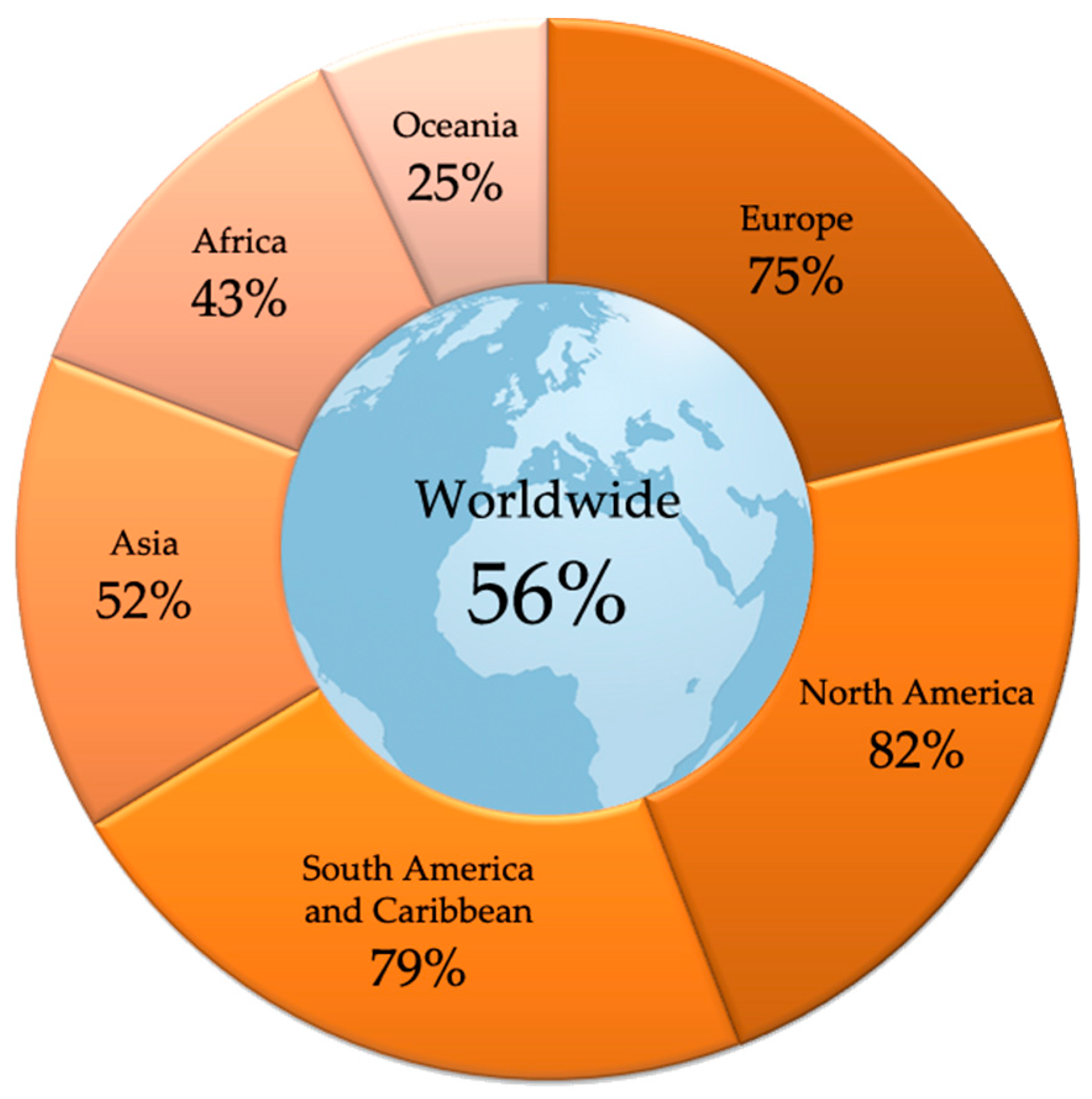

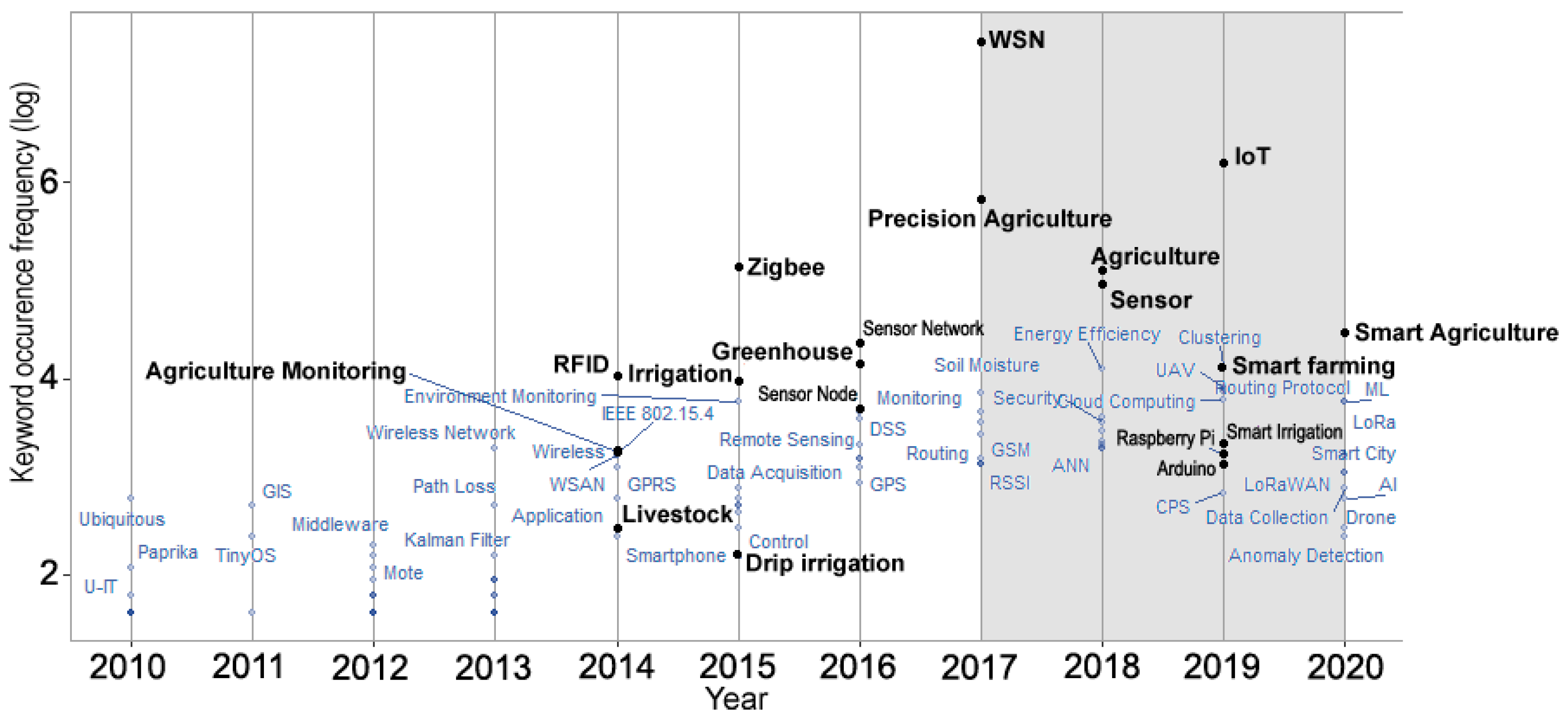







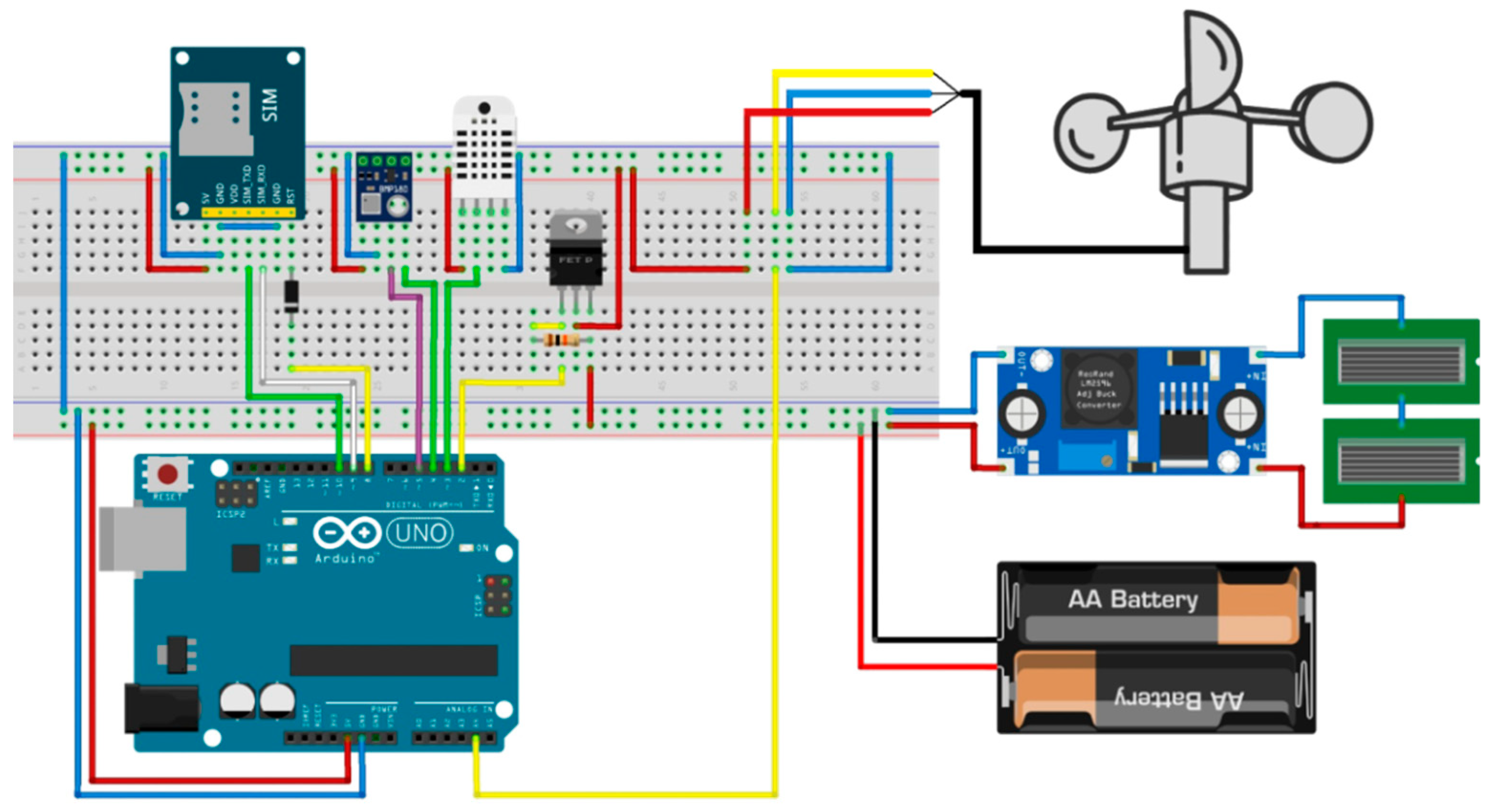
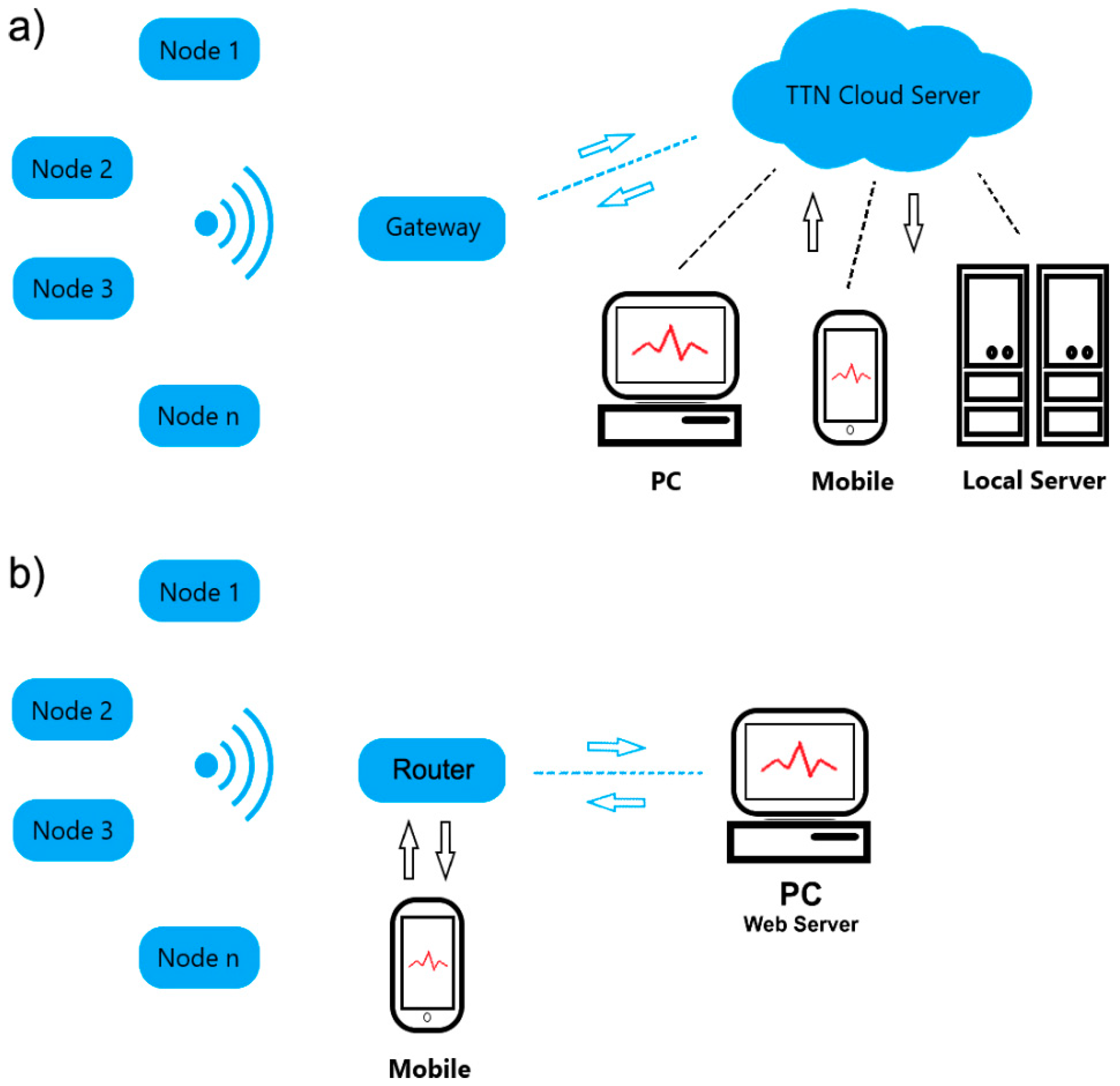
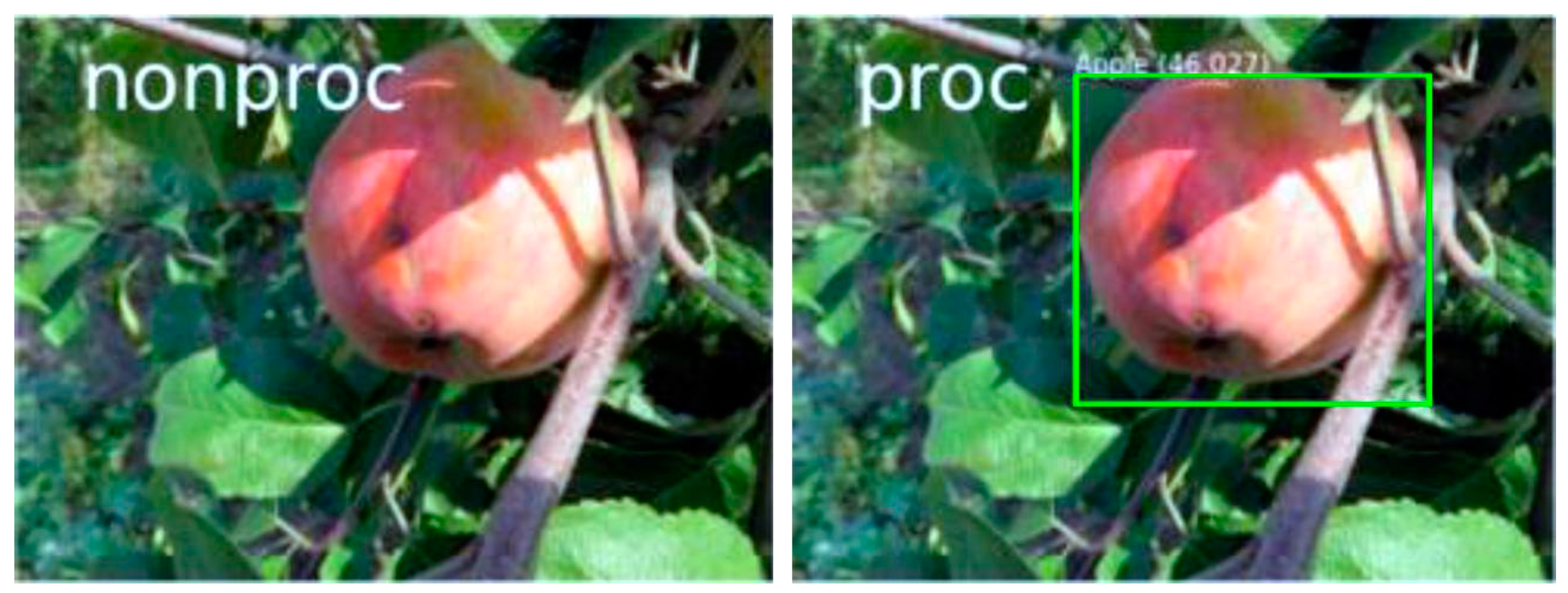


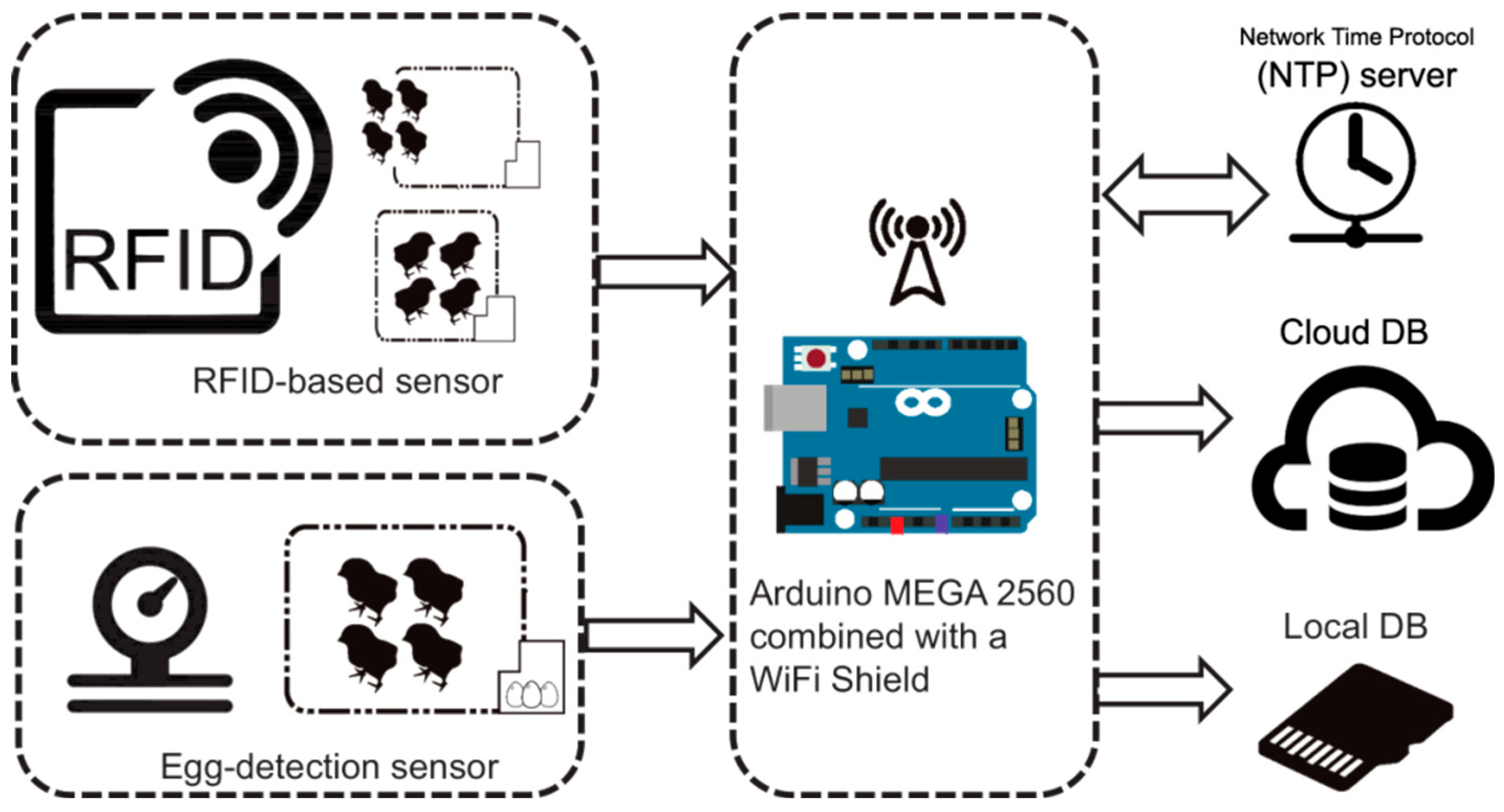
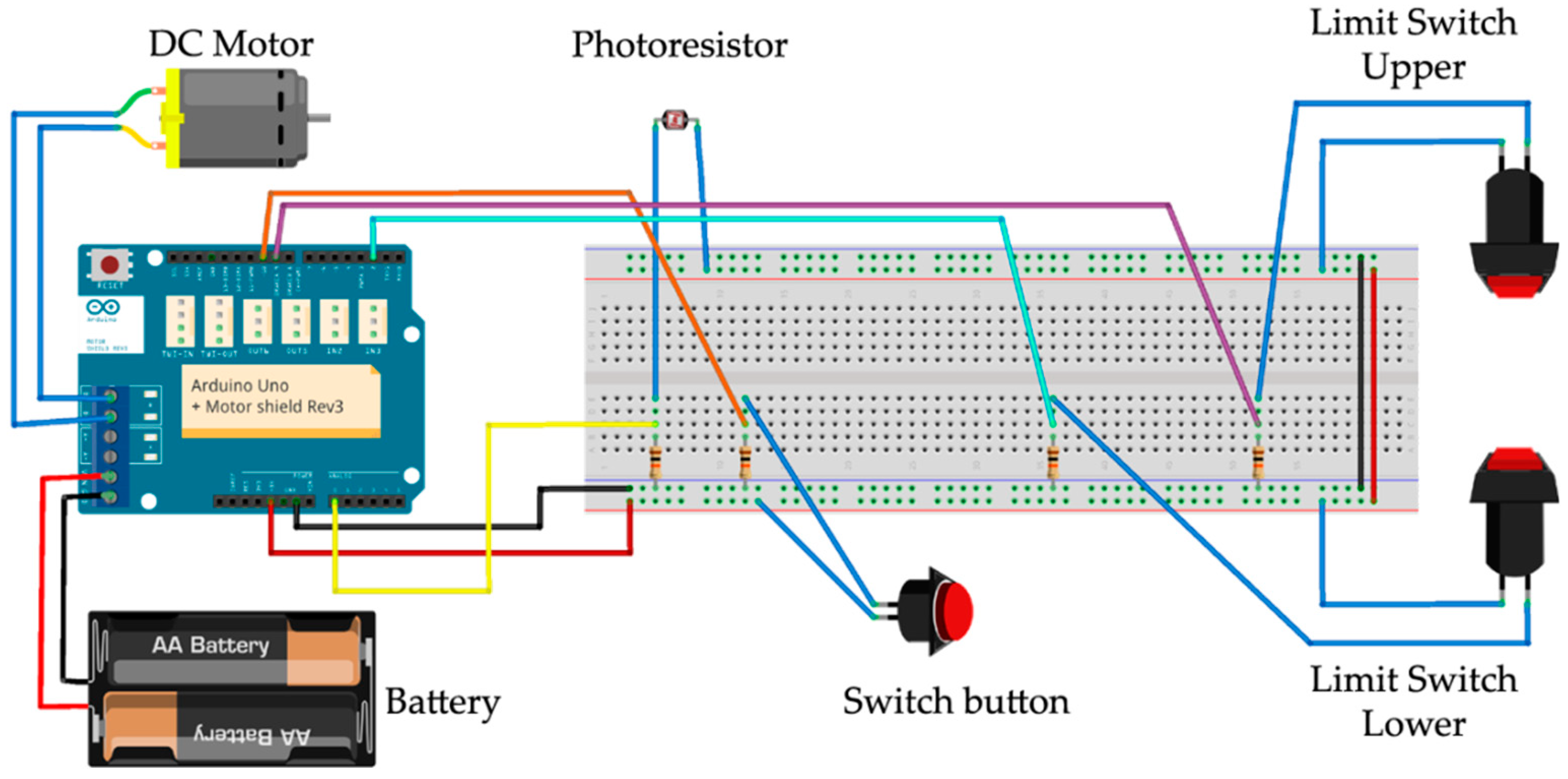
| Cluster | Leading Keyword | Keywords Related to Homestead Automation |
|---|---|---|
| 1 | WSN | Precision agriculture, Zigbee, greenhouse, RFID, environment monitoring, energy harvesting, sensor node |
| 2 | IoT | Smart agriculture, smart farming, cloud computing, LoRa, ML, security, artificial neural networks, Raspberry Pi, WSAN |
| 3 | Sensor network | Clustering, energy efficiency, UAV, routing, energy consumption, localization, LEACH |
| 4 | Sensor | Irrigation, soil moisture, wireless sensor, temperature, wireless, smart irrigation, microcontroller, GSM, monitoring system |
| 5 | Soil moisture sensor | Temperature sensor, humidity sensor, pH sensor |
| Network | Range | Max. Nodes |
|---|---|---|
| WiFi | 50 m–1 km 1 | 2048 |
| Zigbee | 10–100 m | 64,000 |
| Z-Wave LR (long range) | 400 m–1.6 km | 4000 |
| Z-Wave | 100 m | 232 |
| Bluetooth | 25–400 m | 32,767 |
| LoRa | 5 km–20 km | 2553/62,000 |
| NB-IoT | 1 km–10 km | 1000–150,000 |
| SigFox | 10 km–40 km | - |
| Make and Model | Engine | Price Range |
|---|---|---|
| John Deere 8R | Diesel/410 hp | $300,000–$500,000 1 |
| Yanmar | Diesel/88–113 hp | $104,800–$162,330 |
| Monarch | Electric/40 hp | $50,000 |
| Market | (%) of Global Share 10-yr Avg. (2009–18) | 2025 vs. 10-yr Avg. (2009–18) | 2035 vs. 2025 | 2045 vs. 2035 |
|---|---|---|---|---|
| Hi-tech, large scale (North America and Australia) | 15 | ↑ | ↑ | ↓ |
| Western Europe | 7 | ~ | ↓ | ↓ |
| Small-scale Asian | 67 | ↑ | ↑ | ↑ |
| Low-tech, large scale (Latin America) | 4 | ↓ | ↓ | ↓ |
| Eastern Europe | 3 | ↑ | ↓ | ↓ |
| Africa andthe Middle East | 4 | ↓ | ↓ | ↓ |
| Total global | 100 | ↑ | ↑ | ~ |
Publisher’s Note: MDPI stays neutral with regard to jurisdictional claims in published maps and institutional affiliations. |
© 2022 by the authors. Licensee MDPI, Basel, Switzerland. This article is an open access article distributed under the terms and conditions of the Creative Commons Attribution (CC BY) license (https://creativecommons.org/licenses/by/4.0/).
Share and Cite
Dobrojevic, M.; Bacanin, N. IoT as a Backbone of Intelligent Homestead Automation. Electronics 2022, 11, 1004. https://doi.org/10.3390/electronics11071004
Dobrojevic M, Bacanin N. IoT as a Backbone of Intelligent Homestead Automation. Electronics. 2022; 11(7):1004. https://doi.org/10.3390/electronics11071004
Chicago/Turabian StyleDobrojevic, Milos, and Nebojsa Bacanin. 2022. "IoT as a Backbone of Intelligent Homestead Automation" Electronics 11, no. 7: 1004. https://doi.org/10.3390/electronics11071004
APA StyleDobrojevic, M., & Bacanin, N. (2022). IoT as a Backbone of Intelligent Homestead Automation. Electronics, 11(7), 1004. https://doi.org/10.3390/electronics11071004







